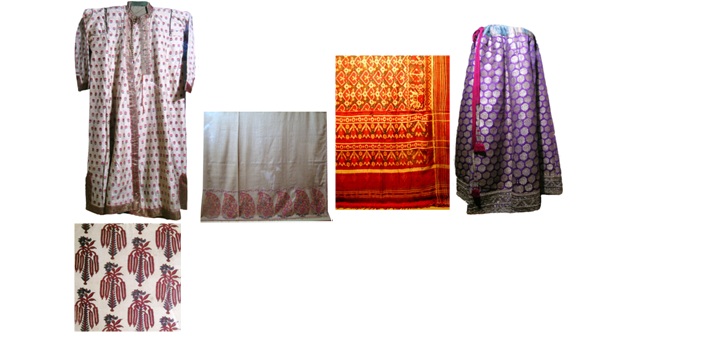|
Indian textiles are known for their fine textures, delicate patterns and their lustrous and vibrant colors throughout the ages. They were coveted both in India and abroad. Legendary Indian muslins were the craze among the aristocratic ladies of the Roman Empire. The printed cotton from Gujarat were considered precious enough to be buried with the dead among the Egyptians, as is evident from the excavated examples from Fostat. The Ikat of Gujarat was held in high esteem in South East Asian countries.
References of textile workshops maintained by the Indian rulers are found from the Mauryan Period (4th Cent. B.C.) which continued in Mughal Period (16th to 19th Cent. A.D.). Skilled weavers were employed who prepared textiles for them, and were awarded for their skill. Every region had its specialty. Woolen shawls of Kashmir, printed cotton, tie and dye fabrics from Gujarat and Rajasthan, patterned muslin (Jamadani) from Dacca and Tanda, silk brocades from Deccan, Gujarat and U.P. (Banaras) were known for their quality and beauty. Subsequently, they became the major trade attraction too, particularly among the Portuguese, Dutch, French and English traders. The popularity of the Indian textiles promoted the European traders to produce imitation of these textiles in their own country. Thus Kashmiri shawls were made in a Scottish village called Paisley and Gujarati cotton prints were reproduced in the villages of South France. Often the Indian textiles manufacturers were asked to change form and pattern to suit the export market but there was always an indigenous market which never got tired of traditional Indian colors and patterns repeated from centuries.
This gallery represents the different aspects of Indian textile. The four major categories of fabrics i.e. cotton, silk, wool and mixed fabric are exhibited here. They are further classified on the basic of the technique of its surface decoration. The major pattern producing techniques are as follows:
The pattern is produced while weaving the fabric on the loom by using extra warp or weft which can be of silk, gold or silver threads, wool or cotton. Some of the well-known examples are silk and zari brocades of Banaras, Ahmedabad, Surat, Paithan, Chanderi, Tanjore and Baluchar of Murshidabad, the cotton Jamdani of Tanda and Dacca. Kashmir Kanikar shawl also fall in this category.
In the tie and dye technique, two methods are used. One is called Ikat, in which warp and weft are tied and dyed separately according to the pattern, before the weaving. This is one of the oldest and complicated form of the textile decoration used in Gujarat, Orissa and Andhra Pradesh. Gujarati Patola, Telia Rumal of Andhra Pradesh and Ikat bordered saris of Orissa and Andhra are the well-known examples of this art. The other method of the tie and dye is called Bandhani. Small knots are tied with threads on the fabric, which is dipped in different colors, as required in the pattern. Rajasthan and Gujarat excel in this art.
Embroidery is the commonly used technique both on personal and professional levels. Every part of India has its own special kind of embroidery. Embroidered Kashmir Shawls called Amlikar, Phulkari of Punjab, Kuchchi and Mochi Bharat of Gujarat, Kasuti of Karnataka, Chikan and applique work of Lucknow, Zardozi work of Banaras, Lucknow, Agra, Jaipur and parts of Punjab are some of the well known examples. Real gold or silver threads, different shaped small decorative pieces, (eg. salma, sitara,) laces etc. are used in such embroidery. Real pearls, precious and semi precious stones were used too, mostly for royal garments.
Decorating the textile, particularly Cotton, with block printing has a long tradition in India. Finely carved wooden blocks and the vibrant vegetable dyes were used for printing beautiful patterns, which made them popular the world over and became a major trade item. Gujarat, Rajasthan, Uttar Pradesh, Andhra Pradesh and Madhya Pradesh are the well-known regions of printed textiles.
The present exhibition is an attempt to project the excellence and acme of the Indian weavers attained through the ages and the exhibition is, therefore, dedicated to those unknown weavers who commanded international approbation.

|
|
